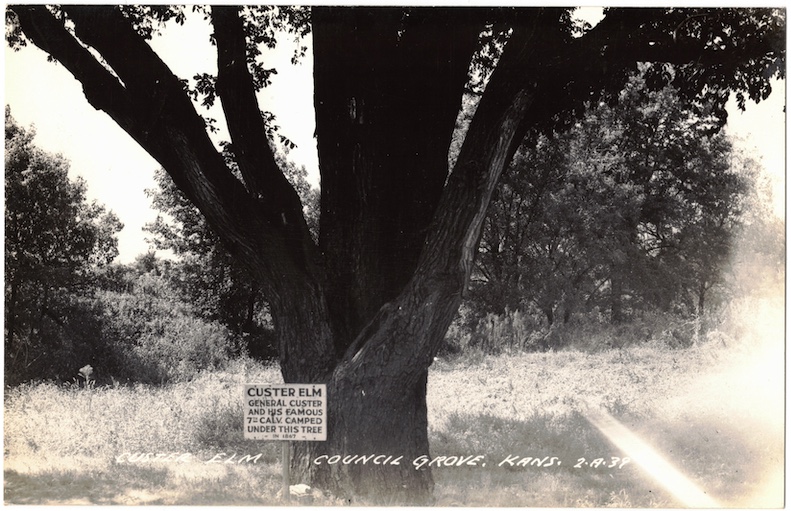Custer’s Elm
ECW is pleased to welcome back guest author Nate Pedersen.
I collect old photo postcards of historic, or witness, trees. (Recently for this blog, I wrote about a postcard in my collection depicting a black walnut tree scarred at the Battle of Pea Ridge). The postcard featured today is of a large American elm tree called Custer’s Elm that stood in Council Grove, Kansas until the 1970s, when Dutch elm disease claimed it. This elm tree was made locally famous by its reputation for sheltering Lt. Col. George Armstrong Custer and the 7th U. S. Cavalry in 1867 while Custer was patrolling the Santa Fe Trail.
Two American Civil War heroes of Gettysburg, George Armstrong Custer and Winfield Scott Hancock, met again out west a little over a year after the war ended. Custer and Hancock, career soldiers, were embroiled in the series of conflicts between the United States and Native Americans collectively known as the Indian Wars.
On July 28, 1866, freshly appointed Lt. Col. Custer took command of the newly formed – and ill-fated – 7th U.S. Cavalry, headquartered at Fort Riley, Kansas (technically, Custer was second-in-command, but he was the leading field officer). The regiment was quickly dispatched to Fort Larned, Kansas to join other forces under the command of Gen. Hancock, who was tasked with convincing Native American tribes in the region to relocate to reservations.
Hancock’s success on the battlefield in the Civil War did not translate to the plains. His attempts at diplomacy quickly disintegrated into open conflict with local tribes after Hancock’s ill-advised decision to burn a combined Cheyenne-Lakota village to the ground. The ensuing series of fights, collectively known as Hancock’s War, were largely a disaster for U.S. forces, eventually leading to Hancock’s reassignment elsewhere.
While embroiled in Hancock’s War, Custer and the 7th frequently patrolled the Santa Fe Trail. The trail connected Franklin, Missouri with Santa Fe, New Mexico, leading through tribal lands of the Lakota, Cheyenne, Arapaho, and Kiowa. Euro-American settlers used the trail for trade and settlement, but the way was dangerous, subject to raids by bands of native warriors, which increased in frequency and severity during Hancock’s War.
While on patrol, the 7th Cavalry discovered a favorite camping spot in Council Grove, Kansas, beneath the spreading shade of this American elm tree. Local residents soon identified the tree with the dashing, curly-haired lieutenant colonel and dubbed it “Custer’s Elm.” Custer himself saw more potential in the area than simply a good camping spot for several hundred men. In 1869, he and another officer, Amos Kimball, purchased a 120-acre farm in Council Grove, the plot of land bordered on the north by his namesake elm. Perhaps it was intended as a business venture after he retired from the army. However, Custer would not live to enjoy it. He was killed, along with over two hundred others of the 7th Cavalry, in the battle of Little Bighorn seven years later.
Custer’s elm far outlived the man. The large tree was a prominent local landmark in Council Grove, featured in postcards for tourists, like this one, after the rise of the automobile increased tourism across the country. The tree survived Custer himself by a full century before Dutch elm disease finally found it in the 1970s. Today, the stump from the tree has been preserved, sheltered beneath a canopy, and can be visited by tourists if you ever find yourself in the area.
————
Nate Pedersen is an award-winning writer and historian in Savannah, Georgia, where he works as the Manager of Archival and Reference Team at Georgia Historical Society. You can find him online at www.natepedersen.com.

Great post. Were the remains ever fashioned into any momentos, given the tree’s provenance?
Also, I doubt my Arkansas ancestor had any opportunity to rest near the Pea Ridge tree. Too busy running around!
Hi John, thanks, I’m glad you enjoyed the post! I don’t know if there ever any momentos made, but a decent section of the stump is preserved to this day. You can see it if you scroll down on this page: https://kansasreflector.com/2022/10/20/searching-for-the-future-of-kansas-council-grove-in-three-trees-three-places-and-three-people/